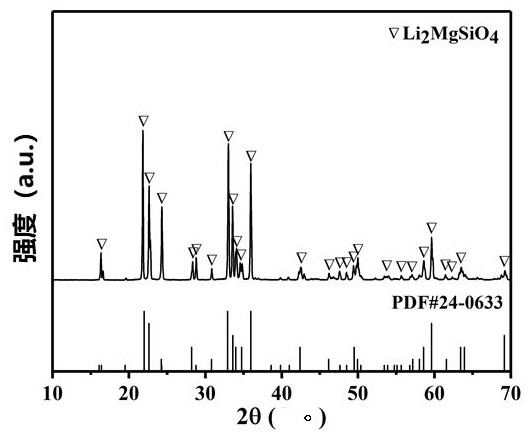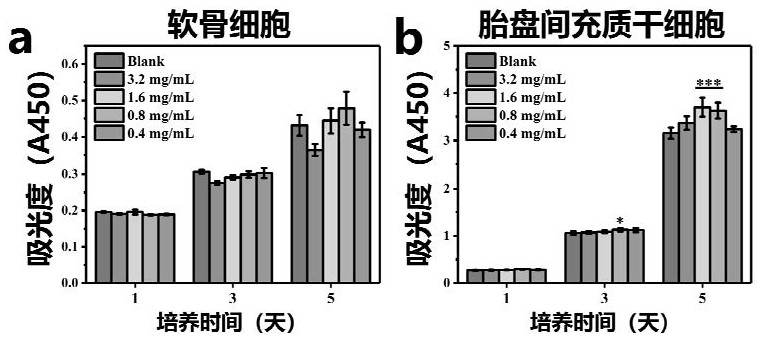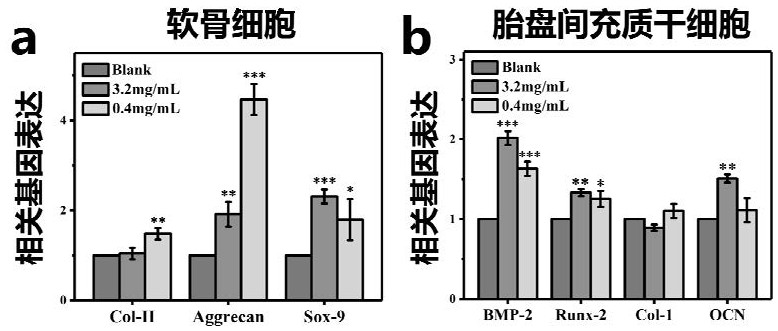Multicellular biological composite scaffold, preparation method and application thereof
A composite scaffold and biological technology, applied in tissue regeneration, prosthesis, additive processing, etc., can solve the problem that the treatment method cannot achieve complete, efficient, large-area repair of bone-cartilage defects, and achieve structural stability, structural integrity, small effect
- Summary
- Abstract
- Description
- Claims
- Application Information
AI Technical Summary
Problems solved by technology
Method used
Image
Examples
Embodiment 1
[0053] Li 2 MgSi 2 o 4 Preparation of bioactive ceramic powder:
[0054] Add 104.66 g of tetraethyl orthosilicate to 72 mL of deionized water and stir, add 20 ml of 2M HNO 3 Hydrolyze tetraethyl orthosilicate, keep stirring until exothermic, and the solution becomes clear;
[0055] Add 68.95g LiNO to it 3 , stir until completely dissolved and then add 128.205g Mg(NO 3 ) 2 , continue to stir until completely dissolved;
[0056] After the sol is formed, put it into an oven at 60°C, and after it becomes a gel, transfer it to 120°C and dry it until it becomes a dry gel completely;
[0057] Quickly ball mill the xerogel for 8 hours, then pass through a 40-mesh sieve;
[0058] The sieved xerogel was sintered at 1000°C for 3 hours, and passed through a 200-mesh sieve to obtain Li 2 MgSi 2 o 4 Bioactive ceramic powder.
[0059] figure 1 For the Li prepared according to the above method 2 MgSi2 o 4 As a result of X-ray diffraction analysis of the powder, it can be seen t...
Embodiment 2
[0061] Li 2 MgSi 2 o 4 Effects of bioactive ceramic powders on the proliferation and differentiation activities of chondrocytes and placental mesenchymal stem cells: To explore Li 2 MgSi 2 o 4 Bioactive ceramic powders for bone-cartilage repair, prepared according to ISO 10993-5 Li 2 MgSi 2 o 4 Lixiviate, specifically Li with mass volume ratio 200mg / mL 2 MgSi 2 o 4 Mix the powder with the special medium for stem cells, seal it and place it in a constant temperature shaker at 37°C for 24h, centrifuge at 4000rpm for 10min, take the supernatant to obtain 200mg / mL Li 2 MgSi 2 o 4 Extract the stock solution and perform gradient dilution with stem cell-specific medium to obtain four gradient concentrations of Li 2 MgSi 2 o 4 Extraction solution.
[0062] to different gradients of Li 2 MgSi 2 o 4 The extracts (0.4mg / mL, 0.8mg / mL, 1.6mg / mL, 3.2mg / mL) were added in proportion to fetal bovine serum, penicillin and streptomycin to obtain different gradients of Li 2 MgS...
Embodiment 3
[0067] Preparation of multicellular biocomposite scaffolds with gradient inorganic powder content:
[0068] Preparations containing different concentrations of Li 2 MgSi 2 o 4 Powder printing paste 1: Weigh 0.7g of gellan gum powder into a jar, add 25ml of sterilized water, seal and place in a 90°C water bath, heat and stir for 30min until the gellan gum is completely dissolved. Turn off the heating switch of the water bath to cool down the solution slowly. Weigh 0.7g methylcellulose and 0.4g sodium alginate and Li 2 MgSi 2 o 4 Powder (according to its content gradient, the mass is 0.07g, 0.035g, 0.014g respectively), when the gellan gum solution cools down to below 80°C, add three kinds of powder, continue to stir until the powder is completely dissolved, and obtain a uniform high Viscosity solution. After the solution was cooled to room temperature, the semi-solid printing paste 1 was obtained.
[0069] Preparation without Li 2 MgSi 2 o 4 Powder printing paste 2: ...
PUM
| Property | Measurement | Unit |
|---|---|---|
| diameter | aaaaa | aaaaa |
| diameter | aaaaa | aaaaa |
| height | aaaaa | aaaaa |
Abstract
Description
Claims
Application Information
 Login to View More
Login to View More - R&D
- Intellectual Property
- Life Sciences
- Materials
- Tech Scout
- Unparalleled Data Quality
- Higher Quality Content
- 60% Fewer Hallucinations
Browse by: Latest US Patents, China's latest patents, Technical Efficacy Thesaurus, Application Domain, Technology Topic, Popular Technical Reports.
© 2025 PatSnap. All rights reserved.Legal|Privacy policy|Modern Slavery Act Transparency Statement|Sitemap|About US| Contact US: help@patsnap.com



